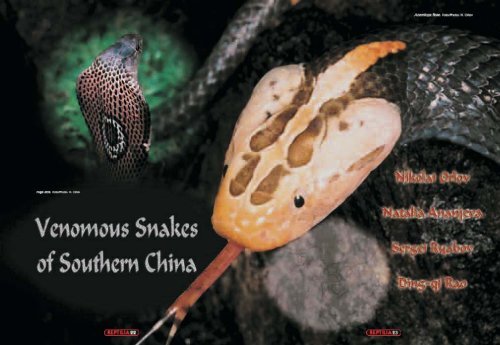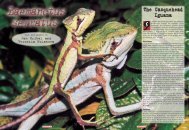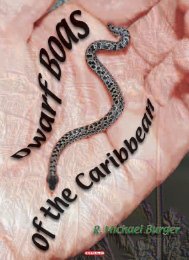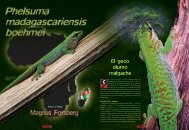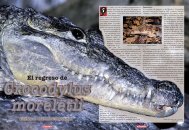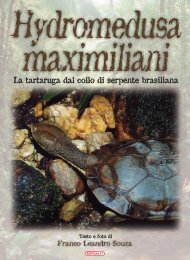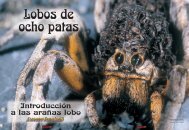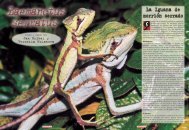Venomous Snakes of Southern China - Reptilia
Venomous Snakes of Southern China - Reptilia
Venomous Snakes of Southern China - Reptilia
You also want an ePaper? Increase the reach of your titles
YUMPU automatically turns print PDFs into web optimized ePapers that Google loves.
The diversity <strong>of</strong> herpetological<br />
fauna in the forests<br />
<strong>of</strong> eastern and southeastern<br />
Asia is comparable<br />
only with that <strong>of</strong> Neotropical<br />
forests. Especially rich and<br />
extraordinary in reptile and amphibian<br />
species is an area covering the<br />
eastern Himalayas, southern <strong>China</strong>,<br />
and northern Indochina. This includes<br />
territories <strong>of</strong> Assam, India;<br />
northern and north-central Myanmar<br />
(Burma); southern Xizang (Tibet),<br />
southern Sichuan, Yunnan, Guangxi,<br />
Guangdong, Hainan, and Taiwan<br />
provinces <strong>of</strong> <strong>China</strong>; northern Laos;<br />
and northern Vietnam.<br />
Especially interesting in <strong>China</strong> is<br />
the South Yunnan Mountainous<br />
Subregion <strong>of</strong> the South <strong>China</strong><br />
zoogeographical region (ZHAO and<br />
ADLER, 1993). This is the western<br />
part <strong>of</strong> the Tonkin region, comprising<br />
the Hoang Lien range and the<br />
parallel Ailao Shan range, which<br />
transect Yunnan Province from<br />
northwest to southeast. Primary<br />
monsoon and rain forests once covered<br />
this territory, but today remain<br />
only in the high mountains and along<br />
steep slopes. These tropical montane<br />
forests support a unique and<br />
diverse herpet<strong>of</strong>auna, and are <strong>of</strong><br />
increasing interest to zoologists,<br />
botanists, and ethnographers.<br />
Naja atra. Photo: N. Orlov<br />
Hemibungarus macclellandi. Photo: N. Orlov<br />
In cooperation with Chinese scientists,<br />
we were able to study the herpet<strong>of</strong>auna<br />
<strong>of</strong> southern <strong>China</strong>, with a<br />
special focus on the venomous<br />
snakes. More than 30 species <strong>of</strong> terrestrial<br />
venomous snakes <strong>of</strong> the<br />
families Elapidae and Viperidae are<br />
found in <strong>China</strong> (ZHAO and<br />
ADLER, 1993; ZHAO et al., 1998;<br />
ZHAO et al., 2000), and most <strong>of</strong><br />
them (except the genera Gloydius,<br />
Vipera, and Ermia) are found in<br />
southern <strong>China</strong>.<br />
The family Elapidae is represented<br />
in southern <strong>China</strong> by members <strong>of</strong><br />
the subfamily Bungarinae: Naja atra<br />
Cantor, 1842; Naja kaouthia Lesson,<br />
1831; Ophiophagus hannah (Cantor,<br />
1836); Bungarus fasciatus (Schneider,<br />
1801); Bungarus multicinctus Blyth,<br />
1860 — and members <strong>of</strong> the subfamily<br />
Elapinae: Hemibungarus macclellandi<br />
(Peters, 1862); Hemibungarus kelloggi<br />
Pope, 1928; Hemibungarus sauteri<br />
(Steindachner, 1913).<br />
The family Viperidae is represented<br />
in southern <strong>China</strong> by the single member<br />
<strong>of</strong> the subfamily Azemiopinae:<br />
Azemiops feae Boulenger, 1888 —<br />
one member <strong>of</strong> the subfamily<br />
Viperinae: Daboia russelli (Shaw<br />
and Nodder, 1797) — and many<br />
members <strong>of</strong> the subfamily Crotalinae:<br />
Deinagkistrodon acutus (Günther,<br />
1888); Ovophis gracilis (Oshima,<br />
1920); Ovophis monticola (Günther,<br />
1864); Ovophis zayuensis (Jiang,<br />
1977); Protobothrops jerdoni<br />
REPTILIA 24<br />
(Günther, 1875); Protobothrops<br />
mucrosquamatus (Cantor, 1839);<br />
Protobothrops xiangchengensis<br />
(Zhao, Jiang, and Huang, 1978);<br />
Trimeresurus albolabris (Gray,<br />
1842); Trimeresurus medoensis<br />
Zhao, 1977; Trimeresurus tibetanus<br />
Huang, 1982; Trimeresurus stejnegeri<br />
Schmidt, 1925; and Trimeresurus<br />
yunnanensis Schmidt, 1925 (ORLOV<br />
et al., 2002, 2002a).<br />
In this article, we will present data<br />
on the distribution and biology <strong>of</strong><br />
some <strong>of</strong> these venomous snakes,<br />
based partly on our own field observations,<br />
and on captive-maintenance<br />
and breeding experience at Tula<br />
Exotarium (Breeding Center <strong>of</strong><br />
Asian snakes).<br />
Family Elapidae<br />
Subfamily Bungarinae<br />
OOpphhiioopphhaagguuss Günther, 1864, is a<br />
monotypic genus distributed in Asia.<br />
OOpphhiioopphhaagguuss hhaannnnaahh (Cantor,<br />
1836), the king cobra or hamadryad,<br />
was originally classified as the<br />
genus Hamadrias from the<br />
Sundarbans region and near<br />
Calcutta, India. This is one <strong>of</strong> the<br />
most fascinating venomous snakes<br />
in the world. It is the largest venomous<br />
snake <strong>of</strong> the Old World, with<br />
a maximum total length <strong>of</strong> 5.5<br />
meters. Most are smaller than this,<br />
but king cobras <strong>of</strong> 4–4.5 meters are<br />
not rare in southern and southeastern<br />
Asia.
Mountain stream on Hainan Island, <strong>China</strong>. Photo: N. Orlov<br />
Ophiophagus hannah is widely<br />
distributed, from India to Vietnam<br />
and from southern <strong>China</strong> through<br />
Indochina, the Philippines and<br />
Indonesia. In southern <strong>China</strong> it<br />
occurs from Hong Kong and Hainan<br />
westward to Yunnan, southwestern<br />
Sichuan, and southeastern Xizang<br />
(GOLAY et al., 1993; ZHAO and<br />
ADLER, 1993; MANTHEY and<br />
GROSSMAN, 1997; ZHAO et al.,<br />
2000).<br />
We have observed Ophiophagus<br />
hannah in different types <strong>of</strong> mountain<br />
forests from foothills to elevations<br />
<strong>of</strong> up to 2,000 meters above sea<br />
level. This species has been recorded<br />
in anthropogenic landscapes (vegetation<br />
influenced by human activities)<br />
and <strong>of</strong>ten inhabits relatively<br />
open and sunlit woodland. In thick<br />
rain and monsoon forests it prefers<br />
clearings and riverbanks where the<br />
canopy cover is not fully closed.<br />
The genus name Ophiophagus<br />
means “snake-eating,” and the king<br />
cobra diet indeed consists largely <strong>of</strong><br />
other snakes, as well as other types<br />
<strong>of</strong> reptiles. In specimens with body<br />
lengths <strong>of</strong> 3–3.2 meters we found<br />
prey species <strong>of</strong> snakes: the Indian<br />
rat snake, Ptyas korros; the Asiatic<br />
water snake, Sinonatrix trianguligera;<br />
the yellowbelly water snake,<br />
Enhydris plumbea; the banded<br />
krait, Bungarus fasciatus; and others<br />
— and large lizards: the East<br />
Indian brown mabuya, Mabuya<br />
multifasciata; and the green pricklenape,<br />
Acanthosaura capra. In captivity,<br />
cannibalism was seen.<br />
A gravid female was recorded on<br />
22 April in the southern part <strong>of</strong> the<br />
Annam mountain range. More than<br />
30 large females examined at zoos in<br />
northern Vietnam in September and<br />
October did not have enlarged follicles;<br />
they were either barren, or had<br />
already laid eggs. In October and<br />
November, large king cobras were<br />
seen basking<br />
during<br />
the<br />
Ophiophagus hannah.<br />
Photo: N. Orlov<br />
daytime. In May and June<br />
this species is crepuscular and<br />
nocturnal.<br />
BBuunnggaarruuss Daudin, 1803, is a<br />
genus <strong>of</strong> 13 species inhabiting<br />
southern and southeastern Asia.<br />
BBuunnggaarruuss ffaasscciiaattuuss (Schneider,<br />
1801), the banded krait or<br />
pama, was originally classified<br />
as the genus Pseudoboa.<br />
It attains a maximum total<br />
length <strong>of</strong> 2 meters or more,<br />
although most specimens do<br />
not exceed 1.5 meters. The<br />
tail is short and blunt.<br />
Bungarus fasciatus is distributed<br />
in the central and northeastern<br />
regions <strong>of</strong> India,<br />
REPTILIA 25<br />
Mountainous terrain in southern Yunnan, <strong>China</strong>. Photo: N. Orlov<br />
Myanmar, Thailand, Laos, Cambodia,<br />
Vietnam, southern <strong>China</strong> including<br />
Hong Kong and Hainan, and islands<br />
<strong>of</strong> Indonesia (Sumatra, Java, and<br />
Borneo) (GOLAY et al., 1993;<br />
ZHAO and ADLER, 1993; DAVID<br />
and INEICH, 1999).<br />
Bungarus fasciatus is one <strong>of</strong> the<br />
most common and abundant venomous<br />
snakes. It lives in a variety <strong>of</strong><br />
habitats, including dense jungle, primary<br />
stratified forest, secondary<br />
bamboo forest at elevations <strong>of</strong> up to<br />
2,500 meters, agricultural land, the<br />
vicinity <strong>of</strong> human settlements,<br />
and even city parks. It does not<br />
avoid steep forest slopes or the<br />
rocky canyons <strong>of</strong> mountain<br />
streams.<br />
Being strongly nocturnal,<br />
this snake hides during the<br />
day in a variety <strong>of</strong> shelters,<br />
and emerges as darkness<br />
falls. A very active hunter, it<br />
is a good swimmer and <strong>of</strong>ten<br />
found in forest streams at<br />
night. Prey items recorded<br />
include the buff-striped keelback,<br />
Amphiesma stolata; the<br />
big-tooth snake, Dinodon<br />
flavozonatus; the Malayan<br />
banded wolf snake, Lycodon<br />
subcinctus; and an Asiatic<br />
water snake, Sinonatrix sp.<br />
We also observed a 1-meter<br />
female that had eaten two<br />
adult spadefoot toads,<br />
Megophrys lateralis.
Ophiophagus hannah basking. Photo: N. Orlov Hemibungarus kelloggi. Photo: N. Orlov<br />
We saw gravid females from the middle <strong>of</strong> May to the<br />
middle <strong>of</strong> July. Clutches consist <strong>of</strong> 3–12 eggs.<br />
BBuunnggaarruuss mmuullttiicciinnccttuuss Blyth, 1860, the many-banded<br />
krait, is distributed in the southern mainland and Taiwan<br />
Province <strong>of</strong> <strong>China</strong>, Laos, Myanmar, and northern<br />
Vietnam (GOLAY et al., 1993; ZHAO and ADLER,<br />
1993; DAVID and INEICH, 1999; MCDIARMID et al.,<br />
1999; ORLOV, 1998a; ZHAO et al., 2000).<br />
This species is found near water in plains and hills,<br />
especially near rice paddies. It is nocturnal and eats<br />
rats, lizards, other snakes, frogs, fishes (mainly loaches),<br />
and eels. In June, the female lays 3–12 eggs, which hatch<br />
in about 48 days.<br />
Bungarus multicinctus has highly neurotoxic venom,<br />
which is used in traditional medicine, as are the gall<br />
bladder, and dried embryos. The meat <strong>of</strong> this species is<br />
also eaten.<br />
NNaajjaa Laurenti, 1768, is an Afro-<br />
Asian genus including more<br />
than 10 species <strong>of</strong> large,<br />
extremely venomous snakes.<br />
NNaajjaa aattrraa Cantor, 1842,<br />
the Chinese cobra, is distributed<br />
in southern and<br />
southeastern <strong>China</strong> including<br />
the islands <strong>of</strong><br />
Hainan and Taiwan, northern<br />
Vietnam, and Laos<br />
(GOLAY et al., 1993; ZHAO<br />
and ADLER, 1993; ORLOV,<br />
1998a; DAVID and INEICH,<br />
1999).<br />
Naja atra occurs in a wide variety<br />
<strong>of</strong> habitats, from rice paddies in maritime<br />
lowlands to various types <strong>of</strong> mountain forests. It can<br />
live at elevations <strong>of</strong> more than 2,000 meters above sea<br />
level. It avoids dark forest with closed canopy. In primary<br />
monsoon and rain forests Naja atra inhabits clearings<br />
and riverbanks. Higher population density is<br />
Bungarus fasciatus. Photo: N. Orlov<br />
REPTILIA 26<br />
observed in the vicinity <strong>of</strong> human settlements, in secondary<br />
forests, and in rice paddies adjacent to forest.<br />
Naja atra is diurnal and crepuscular. We saw hunting<br />
cobras during all daylight periods and as late as 2–3<br />
hours after sunset from March to October, with ambient<br />
temperatures <strong>of</strong> 20–32°C (68–90°F).<br />
The diet <strong>of</strong> Naja atra is highly variable. It preys on any<br />
vertebrates from fishes to mammals. Juveniles eat mosly<br />
amphibians, whereas adults usually prefer reptiles and<br />
mammals — during amphibian breeding periods, however,<br />
adult cobras eat mostly frogs: e.g., the paddy frog,<br />
Fejervarya limnocharis; the Java whipping frog,<br />
Polypedates leucomystax; and the black-spined toad,<br />
Bufo melanostictus.<br />
Mating and egg-laying periods are very extended. We<br />
observed cobras mating in the mountains <strong>of</strong> the western<br />
Tonkin region, at elevations <strong>of</strong> 400–2,000 meters, in<br />
March through May; gravid females with<br />
6–23 eggs were recorded from May to<br />
the end <strong>of</strong> July.<br />
Subfamily Elapinae<br />
HHeemmiibbuunnggaarruuss Peters, 1862,<br />
is a genus <strong>of</strong> four species<br />
distributed in India,<br />
Nepal, Indochina, southern<br />
<strong>China</strong> including the<br />
islands <strong>of</strong> Hainan and<br />
Taiwan, the Ryukyu<br />
Islands <strong>of</strong> Japan, and the<br />
Philippines.<br />
HHeemmiibbuunnggaarruuss mmaacccclleellllaannddii<br />
(Reinhardt, 1844), the oriental<br />
coral snake, was originally classified<br />
as the genus Elaps, from Assam, India. It<br />
can grow to a total length <strong>of</strong> up to 69 centimeters.<br />
The oriental coral snake is distributed in the states <strong>of</strong><br />
Assam and Sikkim in India, Myanmar, Thailand,<br />
Vietnam, Laos, and southern <strong>China</strong> including Taiwan<br />
(GOLAY et al., 1993; ZHAO and ADLER, 1993;
ORLOV, 1998a; DAVID<br />
and INEICH, 1999;<br />
and INEICH, 1999).<br />
MCDIARMID et al.,<br />
This species inhab-<br />
1999; ORLOV et al.,<br />
its mountain slopes<br />
2002; ORLOV and<br />
(sometimes very<br />
RYABOV, 2002).<br />
steep) <strong>of</strong> mon-<br />
We observed<br />
soon and rain<br />
this cryptozoic<br />
forests. We have<br />
species in the<br />
observed it at ele-<br />
mountains <strong>of</strong><br />
vations from 400 to<br />
northern Viet-<br />
2,500 meters. In the<br />
nam and south-<br />
mountains <strong>of</strong> the west-<br />
Azemiops feae. Photo: N. Orlov<br />
ern <strong>China</strong> at elevaern<br />
Tonkin region it prefers<br />
tions from 600 to 1,100<br />
areas <strong>of</strong> karst covered with well-<br />
meters. POPE (1935) reported the species at elevations<br />
drained, layered forests (tree<br />
<strong>of</strong> 600–1,500 meters in <strong>China</strong>. In addition to our own<br />
species <strong>of</strong> differing heights and<br />
observations, we used a questionnaire and color photo-<br />
sunlight requirements).<br />
graphs to survey the local people, especially hunters and<br />
Hemibungarus macclellandi is crepuscular and noc- foresters. Virtually everyone working regularly in the<br />
turnal, being especially active at night. It emerges on forest recognized this snake and said it was very rarely<br />
rainy nights in the beginning <strong>of</strong> March, at temperatures seen on forested mountain slopes. Sightings are proba-<br />
as low as 14°C (57°F). Gravid females were recorded in bly so rare partly because <strong>of</strong> the extremely secretive<br />
May and June at elevations <strong>of</strong> 800–1,000 meters. lifestyle <strong>of</strong> the species. It is interesting to note that most<br />
Clutches consist <strong>of</strong> 7–12 eggs. Recorded prey items recorded sightings are <strong>of</strong> subadult specimens.<br />
included the dwarf snake Calamaria pavimentata; a Our observations and data received from the local<br />
worm snake, Typhlops sp.; and a ground skink, Scincella sp. people indicate that in northern Vietnam Azemiops feae<br />
HHeemmiibbuunnggaarruuss kkeellllooggggii Pope, 1928, Kellogg’s coral occurs in habitats characterized by the presence <strong>of</strong> bam-<br />
snake, is distributed in northern Laos, northern boo and tree-fern thickets interspersed with sunlit open<br />
Vietnam, and the provinces <strong>of</strong> Sichuan, Guizhou, areas, a thick layer <strong>of</strong> leaf litter and decomposing tree<br />
Zhejiang, Jiangxi, Fujian, Hainan, and Guangxi in <strong>China</strong> ferns, and karst outcrops, well-drained by numerous sur-<br />
(GOLAY et al., 1993; ZHAO and ADLER, 1993;<br />
ORLOV, 1998a; DAVID and INEICH, 1999).<br />
This nocturnal species is found in mountain forests.<br />
We have observed it at elevations from 600 to 1,500<br />
meters. It preys on other species <strong>of</strong> snakes. In May,<br />
females lay 5–8 elongate eggs.<br />
face and underground streams. The snake probably<br />
Family Viperidae<br />
Subfamily Azemiopinae<br />
AAzzeemmiiooppss Boulenger, 1888, is a monotypic genus.<br />
AAzzeemmiiooppss ffeeaaee Boulenger, 1888, Fea’s viper, is one <strong>of</strong><br />
the most mysterious viperid snakes. Until the last<br />
decade, only a few specimens were known. The species<br />
was named in honor <strong>of</strong> prominent Italian naturalist<br />
Leonardo Fea <strong>of</strong> the Natural History Museum in<br />
Genoa. During a 4-year field study (1885–1889) in<br />
Burma (now Myanmar) he collected insects and other<br />
invertebrates, amphibians, reptiles, and birds<br />
(HALLERMAN et al., 2002). He found Azemiops feae<br />
in the Kakhien (=Kakhyen) Hills, several kilometers<br />
from Bhamo, on the border with Yunnan, <strong>China</strong><br />
(ORLOV and RYABOV, 2002).<br />
Azemiops feae is distributed in northern Myanmar;<br />
the provinces <strong>of</strong> southeast Xizang, Yunnan, Guangxi,<br />
Guizhou, Sichuan, Fujian, Zhejiang, Jiangxi, and<br />
Shaanxi in <strong>China</strong>; and the provinces <strong>of</strong> Vinh-phu, Bacthai,<br />
Cao-bang, and Lang-son <strong>of</strong> northern Vietnam<br />
(GOLAY et al., 1993; ZHAO and ADLER, 1993;<br />
ORLOV, 1995, 1997, 1998b; ZHAO et al., 1998; DAVID<br />
REPTILIA 27<br />
Deinagkistrodon acutus at the edge <strong>of</strong> a mountain stream. Photo: N. Orlov
spends most <strong>of</strong> its life in the crevices<br />
and galleries <strong>of</strong> the karst fields,<br />
where it can find prey without<br />
appearing above ground. Limited<br />
data on feeding in nature show that<br />
the diet <strong>of</strong> Azemiops feae includes<br />
rodents and shrews (GREEN, 1992)<br />
associated with the karst outcrops<br />
cut by swift mountain streams.<br />
We recorded Azemiops feae in<br />
mid May and early June from 3–4<br />
a.m. Activity was observed during<br />
light rainfall, with air temperatures<br />
<strong>of</strong> 18–20°C (64–68°F) near the soil<br />
surface. The snakes moved slowly,<br />
sometimes appearing on the surface<br />
entirely, and sometimes disappearing<br />
in the forest litter. The juvenile<br />
specimens found in October and<br />
November were active on the surface<br />
at air temperatures <strong>of</strong> 16–19°C<br />
(61–66°F) in the evening, from just<br />
after dark at 7 p.m. until 10–11 p.m.<br />
Their appearance on the surface was<br />
always during light rainfall.<br />
We also have long-term experience<br />
with Azemiops feae in captivity.<br />
It has been found that this viper<br />
cannot tolerate dry conditions.<br />
Even with relative air humidity<br />
approaching 100 percent, the substrate<br />
must be kept very wet (but<br />
loose). Otherwise, the snake will<br />
lose mobility and its skin will quickly<br />
become dry and wrinkled.<br />
During the active period (February<br />
through November), daytime temperature<br />
should be kept at 23–27°C<br />
(73–81°F); nighttime temperature,<br />
at 17–19°C (63–66°F). This snake<br />
feeds at temperatures as low as<br />
16–17°C (61–63°F), and is able to<br />
digest food at temperatures as low<br />
as 19–20°C (66–68°F). In the loose<br />
wet substrate <strong>of</strong> the terrarium, captive<br />
vipers quickly burrow a network<br />
<strong>of</strong> underground tunnels and<br />
chambers.<br />
During the active period, shedding<br />
in captive specimens occured about<br />
once every 6 weeks. Over a period<br />
<strong>of</strong> 6 years in a terrarium, one female<br />
grew from 32 centimeters to 98<br />
centimeters in total length. Over the<br />
same time period, a male grew from<br />
30 centimeters to 92 centimeters.<br />
Specimens <strong>of</strong> such a large size have<br />
not been recorded in the wild.<br />
REPTILIA 28<br />
Hibernation in captivity was set up<br />
in very moist substrate at temperatures<br />
<strong>of</strong> 13–14°C (55–57°F) for 60<br />
days from the end <strong>of</strong> December until<br />
the end <strong>of</strong> February.<br />
During the active period, Fea’s<br />
vipers ate once every 8–12 days.<br />
They were fed mice, newborn rats,<br />
lizards (Hemidactylus sp.), and<br />
pieces <strong>of</strong> chicken prepared with the<br />
scent <strong>of</strong> rat or mouse.<br />
Unlike many other terrestrial<br />
vipers, Azemiops feae is relatively<br />
sluggish and unaggresive. When<br />
mating, the male aligns himself parallel<br />
with a female, twitches against<br />
her, and turns his tail and cloaca<br />
under hers. The female then lifts her<br />
tail, the cloacas are drawn together,<br />
and copulation takes place, lasting<br />
for about 10 minutes. Copulation<br />
may be repeated several times over a<br />
period <strong>of</strong> 10–12 days (ORLOV and<br />
RYABOV, 2002).<br />
The female is gravid for about 90<br />
days before laying eggs. We have<br />
observed two clutches <strong>of</strong> 5 eggs each<br />
laid by this species.<br />
Subfamily Crotalinae<br />
DDeeiinnaaggkkiissttrrooddoonn Gloyd, 1979, is a<br />
monotypic genus.<br />
DDeeiinnaaggkkiissttrrooddoonn aaccuuttuuss (Günther,<br />
1888), the Chinese copperhead, was<br />
first classified as the genus Halys,<br />
from the mountains north <strong>of</strong><br />
Kinkiang (=Jinjiang Shi), Jiangxi<br />
Province, <strong>China</strong>.<br />
Deinagkistrodon acutus is distributed<br />
in Taiwan and central mainland<br />
<strong>China</strong> from Zhejiang and Fujian<br />
westward to Guizhou and southeastern<br />
Sichuan, and southward to<br />
northern Vietnam, and possibly<br />
Laos (GOLAY et al., 1993; ZHAO<br />
and ADLER, 1993; DAVID and<br />
INEICH, 1999; MCDIARMID et al.,<br />
1999; ZHAO et al., 2000; ORLOV<br />
et al., 2002).<br />
This species lives in forested areas<br />
<strong>of</strong> mountains. It is <strong>of</strong>ten found on<br />
rocks in mountain streams, from<br />
lower hills and mountains to elevations<br />
up to 2,000 meters. It is very<br />
active in the evenings and on rainy<br />
or cloudy days. It feeds on frogs,<br />
lizards, birds, and rats. On the<br />
mountain Fan Si Pan (Sa Pa District,
Deinagkistrodon acutus in the forest. Photo: N. Orlov<br />
Lao Cai Province) it has been seen<br />
feeding on bamboo rats (genus<br />
Rhizomys). Local people indicate<br />
that the adult snakes live in association<br />
with bamboo rat colonies, using<br />
the rat tunnels for shelter and<br />
ambush. Snake hunters visit these<br />
colonies at the proper time, and<br />
locate snakes by listening for the<br />
peeping sound emitted by rats being<br />
attacked in their underground nest<br />
chambers. The hunters then dig up<br />
the tunnels and catch the snakes.<br />
Deinagkistrodon acutus is<br />
used in Vietnam and <strong>China</strong><br />
for food and in traditional<br />
medicine.<br />
A female measuring<br />
about 1 meter in<br />
total length was<br />
captured at the<br />
end <strong>of</strong> June in<br />
Mau Son (Lang<br />
Son Province), at<br />
an elevation <strong>of</strong> 600<br />
meters. In captivity, this<br />
snake feeds on frogs, small rats, and<br />
other rodents. After eating, it <strong>of</strong>ten<br />
remains immobile for up to 19 days<br />
and 8 hours.<br />
This species is oviparous. Copulation<br />
takes place in May, and again in<br />
September and October. Clutches<br />
<strong>of</strong> 15–35 eggs are laid between July<br />
and September (sperm from the<br />
autumn copulations is stored until<br />
the following year). Eggs measure<br />
45–55 x 25–30 millimeters, weigh<br />
about 15 grams, and already contain<br />
developed embryos at the time <strong>of</strong><br />
laying. The female guards and incubates<br />
the eggs. Newly hatched<br />
young measure 21.5–24 centimeters<br />
in total length. The female abandons<br />
her young about 24–30 days<br />
after they hatch. The young snakes<br />
eat mostly frogs, but shift to mice as<br />
they grow. ■<br />
Bibliography<br />
DAVID, P. and I. INEICH,<br />
1999. Les serpents venimeux du monde: systématique<br />
et répartition. Dumerilia 3.<br />
GOLAY, P., H. M. SMITH, D. G.<br />
BROADLEY, J. R. DIXON, C. MCCARTHY,<br />
J. C. RAGE, B. SCHATTI, and M. TORIBA,<br />
1993. Endoglyphs and other Major <strong>Venomous</strong><br />
<strong>Snakes</strong> <strong>of</strong> the World. A Checklist. Azemiops<br />
S. A. Herpetological Data Center, Aire-Geneve.<br />
GREEN, H. W., 1992. The ecological and<br />
behavioral context for pit viper evolution. In:<br />
REPTILIA 29<br />
Bungarus multicinctus.<br />
Photo: N. Orlov<br />
Eds. Campbell J. A. and E. D. Broodie. Biology<br />
<strong>of</strong> the Pit Vipers. Selva Press, Tyler, Texas.<br />
HALLERMANN J., N. ANANJEVA, N.<br />
ORLOV, and F. TILLACK, 2002. Leonardo<br />
Fea’s historical collection <strong>of</strong> Amphibia and<br />
<strong>Reptilia</strong> from Burma deposited at the<br />
Zoologisches Museum Hamburg. Mitt. Hamb.<br />
Zool. Mus. Inst. 99: 139–153.<br />
MANTHEY, U. and W. GROSSMANN,<br />
1997. Amphibien und Reptilien Südostasiens.<br />
Natur & Tier – Verlag, Münster.<br />
MCDIARMID, R. W., J. A. CAMPBELL,<br />
and T’S. A. TOURÉ, 1999. Snake species<br />
<strong>of</strong> the world. A taxonomic and geographic<br />
reference. Vol. 1. Herpetologists’ League,<br />
Washington D.C.<br />
ORLOV, N. L., 1995. Rare snakes <strong>of</strong> the<br />
mountainous forests <strong>of</strong> northern Indochina.<br />
Russ. J. <strong>of</strong> Herpetol. 2(2): 179–183.<br />
ORLOV, N. L., 1997. Viperid snakes<br />
(Viperidae Bonaparte, 1840) <strong>of</strong> Tam-Dao<br />
mountain ridge (Vinh-Phu and Bac-Thai<br />
Provinces, Vietnam). Russ. J. <strong>of</strong> Herpetol.<br />
4(1): 64–74.<br />
ORLOV (ORLOW), N. L, 1998a. Die Giftschlangen<br />
der vietnamesischen Bergwälder.<br />
Teil 1. Familie Elapidae. Herpet<strong>of</strong>auna 116,<br />
October: 11–19.<br />
ORLOV (ORLOW), N. L, 1998b. Die<br />
Giftschlangen der vietnamesischen Bergwälder.<br />
Teil 2. Familie Viperidae. Herpet<strong>of</strong>auna 117,<br />
December: 5–14.<br />
ORLOV N., N. ANANJEVA, A. BARA-<br />
BANOV, S. RYABOV, and R. KHALIKOV,<br />
2002. Diversity <strong>of</strong> vipers (Azemiopinae,<br />
Crotalinae) in East, Southeast, and South<br />
Asia: Annotated checklist and natural history<br />
data (<strong>Reptilia</strong>: Squamata: Serpentes:<br />
Viperidae). Faunistische Abhandlungen.<br />
Staatliches Museum fur Tierkunde. Dresden.<br />
23 (10): 177–218.<br />
ORLOV N., N. ANANJEVA, and<br />
R. KHALIKOV, 2002a.<br />
Natural history <strong>of</strong> pit<br />
vipers in Eastern and<br />
Southeastern Asia.<br />
In: Schuett, G., M.<br />
Hoggren, M. Douglas,<br />
and H. Greene (Eds.).<br />
Biology <strong>of</strong> the Vipers,<br />
pp. 345–361.<br />
ORLOV N. L. and S.<br />
A. RYABOV, 2002.<br />
Zur Kenntnis von<br />
Fea’s Viper, Azemiops<br />
feae Boulenger, 1888.<br />
Sauria 24(1): 17–22.<br />
POPE, C. H., 1935. The<br />
Reptiles <strong>of</strong> <strong>China</strong>. Vol. 10,<br />
Natural History <strong>of</strong> Central Asia.<br />
Amer. Mus. Nat. Hist., New York.<br />
ZHAO, E.-M. and K. ADLER, 1993.<br />
Herpetology <strong>of</strong> <strong>China</strong>. Contribution to<br />
Herpetology. No. 10, Soc. Study Amphib.<br />
Reptiles.<br />
ZHAO, E.-M, M. HUANG, Y. ZONG, et<br />
al, 1998. Serpentes. In: Fauna Sinica, <strong>Reptilia</strong>,<br />
Vol. 3, Squamata. Science Press, Beijing,<br />
<strong>China</strong>.<br />
ZHAO, E.-M., H. CHANG, H. ZHAO,<br />
and K. ADLER, 2000. Revised checklist <strong>of</strong><br />
Chinese amphibia and reptilia. Sichuan Journ.<br />
Zoology 19(3): 196–207.


